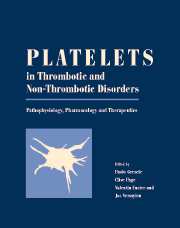Book contents
- Frontmatter
- Contents
- List of contributors
- Editors' preface
- PART I PHYSIOLOGY
- 1 History of platelets
- 2 Production of platelets
- 3 Morphology and ultrastructure of platelets
- 4 Platelet heterogeneity: physiology and pathological consequences
- 5 Platelet membrane proteins as adhesion receptors
- 6 Dynamics of the platelet cytoskeleton
- 7 Platelet organelles
- 8 Platelet receptors for thrombin
- 9 Platelet receptors: ADP
- 10 Platelet receptors: prostanoids
- 11 Platelet receptors: collagen
- 12 Platelet receptors: von Willebrand factor
- 13 Platelet receptors: fibrinogen
- 14 Platelet signalling: GTP-binding proteins
- 15 Platelet phospholipases A2
- 16 Roles of phospholipase C and phospholipase D in receptor-mediated platelet activation
- 17 Platelet signalling: calcium
- 18 Platelet signalling: protein kinase C
- 19 Platelet signalling: tyrosine kinases
- 20 Platelet signalling: cAMP and cGMP
- 21 Platelet adhesion
- 22 The platelet shape change
- 23 Aggregation
- 24 Amplification loops: release reaction
- 25 Amplification loops: thromboxane generation
- 26 Platelet procoagulant activities: the amplification loops between platelets and the plasmatic clotting system
- 27 Platelets and chemotaxis
- 28 Platelet–leukocyte interactions relevant to vascular damage and thrombosis
- 29 Vascular control of platelet function
- PART II METHODOLOGY
- PART III PATHOLOGY
- PART IV PHARMOLOGY
- PART V THERAPY
- Afterword: Platelets: a personal story
- Index
- Plate section
10 - Platelet receptors: prostanoids
from PART I - PHYSIOLOGY
Published online by Cambridge University Press: 10 May 2010
- Frontmatter
- Contents
- List of contributors
- Editors' preface
- PART I PHYSIOLOGY
- 1 History of platelets
- 2 Production of platelets
- 3 Morphology and ultrastructure of platelets
- 4 Platelet heterogeneity: physiology and pathological consequences
- 5 Platelet membrane proteins as adhesion receptors
- 6 Dynamics of the platelet cytoskeleton
- 7 Platelet organelles
- 8 Platelet receptors for thrombin
- 9 Platelet receptors: ADP
- 10 Platelet receptors: prostanoids
- 11 Platelet receptors: collagen
- 12 Platelet receptors: von Willebrand factor
- 13 Platelet receptors: fibrinogen
- 14 Platelet signalling: GTP-binding proteins
- 15 Platelet phospholipases A2
- 16 Roles of phospholipase C and phospholipase D in receptor-mediated platelet activation
- 17 Platelet signalling: calcium
- 18 Platelet signalling: protein kinase C
- 19 Platelet signalling: tyrosine kinases
- 20 Platelet signalling: cAMP and cGMP
- 21 Platelet adhesion
- 22 The platelet shape change
- 23 Aggregation
- 24 Amplification loops: release reaction
- 25 Amplification loops: thromboxane generation
- 26 Platelet procoagulant activities: the amplification loops between platelets and the plasmatic clotting system
- 27 Platelets and chemotaxis
- 28 Platelet–leukocyte interactions relevant to vascular damage and thrombosis
- 29 Vascular control of platelet function
- PART II METHODOLOGY
- PART III PATHOLOGY
- PART IV PHARMOLOGY
- PART V THERAPY
- Afterword: Platelets: a personal story
- Index
- Plate section
Summary
Introduction
Prostanoids, consisting of thromboxane (Tx) and prostaglandins (PGs), are oxygenated metabolites of the polyunsaturated, essential fatty acid, arachidonic acid. Prostaglandin G/H synthase, also called cyclooxygenase (COX), catalyses the rate-limiting step in the synthesis of prostanoids. It is a bisfunctional enzyme, causing biotransformation of arachidonic acid to the cyclic endoperoxides, PGG2 to PGH2, via sequential cyclooxygenase and peroxidase activities. Prostanoids are produced in response to diverse physical and chemical stimuli and exert their actions by binding to G protein-coupled receptors (GPCRs) which are located on the surface of the same or nearby cells. Prostanoid receptors specific for TxA2, prostacyclin (PGI2), PGE2, PGD2, and PGF2α are termed TP, IP, EP, DP, and FP, respectively. As discussed later, isoforms of some of these receptors have been identified. Each receptor binds its cognate ligand with a Kd value of 1.3–40 nM. Most prostanoids cross-react with receptors other than their own, with affinities usually more than two orders of magnitude below this range. There are also some compounds that act potently on two different receptors. For example, iloprost activates not only the IP, but also the EP1, and PGE1 displaces the binding of 3H-iloprost more potently than other IP agonists, indicating that PGE1 binds not only to EP isoforms, but also to the IP. Prostanoids play an important role in platelet physiology. The major arachidonic acid metabolite in platelets is TxA2. TxA2 is also synthesized by other cells, including macrophages, monocytes, and lung parenchyma. In platelets, TxA2 is produced in response to activation by conventional agonists, such as thrombin and ADP, but TxA2 is also a platelet activator itself.
- Type
- Chapter
- Information
- Platelets in Thrombotic and Non-Thrombotic DisordersPathophysiology, Pharmacology and Therapeutics, pp. 140 - 157Publisher: Cambridge University PressPrint publication year: 2002



